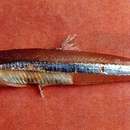Morphology
provided by Fishbase
Anal spines: 0; Analsoft rays: 17 - 20
- Recorder
- Crispina B. Binohlan
Migration
provided by Fishbase
Oceanodromous. Migrating within oceans typically between spawning and different feeding areas, as tunas do. Migrations should be cyclical and predictable and cover more than 100 km.
- Recorder
- Crispina B. Binohlan
Diagnostic Description
provided by Fishbase
Diagnosis: Body somewhat compressed, belly with 4-8 small needle-like pre-pelvic scutes; a small pre-dorsal spine in some specimens; maxilla tip pointed, reaching to or beyond hind border of pre-operculum, the latter concave, indented near maxilla tip; lower gillrakers 21 to 28; fine teeth on upper edge of hyoid bones; anal fin short, usually with 3 unbranched and 14-17 branched finrays, its origin below about middle of dorsal fin base; a double pigment line on back behind dorsal fin; tail deep yellow, at least in Indian specimens (Ref. 189). Of species with an indented pre-operculum, Stolephorus andhraensis has fewer gillrakers, 20-21, and S. ronquilloi has more gillrakers, 28-30; other species with a pre-dorsal spine also have a spine on the pelvic scute, like in S. dubiosus, S. baganensis and S. tri; hyoid tooth patches are present in S. commersonnii, but pre-operculum rounded, scutes usually 1-4, and in S. carpenteriae, but no pigment lines on back, anal origin under anterior part of dorsal fin base (Ref. 189).Description: Body somewhat compressed (Ref. 189). Maxilla tip pointed, reaching to or beyond hind border of pre-operculum (Ref. 30573). Number of gillrakers on upper limb 16-20, gillrakers on lower limb 21-28 (Ref. 189, 122132). Anal-fin origin below dorsal-fin base (Ref. 30573). With 4-8 small needle-like pre-pelvic scutes, no post-pelvic scutes (Ref. 189, 30573).Colouration: A double pigment line on back behind dorsal fin; tail deep yellow, at least in Indian specimens (Ref. 189, 30573).
- Recorder
- Crispina B. Binohlan
Biology
provided by Fishbase
Coastal pelagic (Ref. 68964). A schooling species occurring in coastal waters. More data needed based on correct identifications. The record from the Godavari estuary implies tolerance of lowered salinities, but the identity of the material is uncertain (perhaps S. waitei). Appears to be fairly common throughout its range. Used as bait in the tuna fishery in the South Pacific, although rather fragile.
- Recorder
- Crispina B. Binohlan
Importance
provided by Fishbase
fisheries: commercial; bait: usually
- Recorder
- Crispina B. Binohlan
分布
provided by The Fish Database of Taiwan
分布於印度-西太平洋區,包括北印度洋的安達灣及西太平洋的泰國、爪哇、香港及臺灣等海域。臺灣分布於南部及澎湖海域。
利用
provided by The Fish Database of Taiwan
全年皆產,澎湖沿海較多,是魩鱙漁業的重要漁獲物之一,多以焚寄網捕獲,新鮮時可清蒸,但大多曬乾後出售,炒花生、辣椒或煮湯。
描述
provided by The Fish Database of Taiwan
體長形,腹部圓,僅有4-8枚小稜鱗位於胸鰭與腹鰭間。頭略長。吻鈍圓,突出。眼中大。口大,略下斜;上頜前端突出於下頜,上頜骨末端尖,向後延伸達前鰓蓋骨之後緣;前鰓蓋骨之後緣呈凹入。鰓耙細長而密,下枝鰓耙在25-28間。體被圓鱗,鱗小而薄,易脫落,無側線。背鰭短,位於體中央,前方貝1棘狀稜鱗;腹鰭短,末端未達背鰭起點;臀鰭起點位於背鰭中部下方。體灰白色,體側中央由頭部起始至尾柄具一條銀白色帶。各鰭多半透明而略呈青灰色。
棲地
provided by The Fish Database of Taiwan
近沿海表層魚類,濾食浮游生物為生,具群游性。多於表層至20公尺深之海域活動。
Stolephorus insularis: Brief Summary
provided by wikipedia EN
Stolephorus insularis, the Hardenberg's anchovy, is a species of ray-finned fish in the family Engraulidae. It is found in the Indo-Pacific.
- license
- cc-by-sa-3.0
- copyright
- Wikipedia authors and editors
Stolephorus insularis
(
Basque
)
provided by wikipedia EU
(RLQ=window.RLQ||[]).push(function(){mw.log.warn("Gadget "ErrefAurrebista" was not loaded. Please migrate it to use ResourceLoader. See u003Chttps://eu.wikipedia.org/wiki/Berezi:Gadgetaku003E.");});
- license
- cc-by-sa-3.0
- copyright
- Wikipediako egileak eta editoreak
Stolephorus insularis: Brief Summary
(
Basque
)
provided by wikipedia EU
Stolephorus insularis Stolephorus generoko animalia da. Arrainen barruko Engraulidae familian sailkatzen da.
- license
- cc-by-sa-3.0
- copyright
- Wikipediako egileak eta editoreak
Stolephorus insularis: Brief Summary
(
Dutch; Flemish
)
provided by wikipedia NL
Stolephorus insularis is een straalvinnige vis uit de familie van de ansjovissen (Engraulidae) en behoort derhalve tot de orde van haringachtigen (Clupeiformes). De vis kan een lengte bereiken van 8 centimeter.
- license
- cc-by-sa-3.0
- copyright
- Wikipedia-auteurs en -editors
島側帶小公魚
(
Chinese
)
provided by wikipedia 中文维基百科
島側帶小公魚: Brief Summary
(
Chinese
)
provided by wikipedia 中文维基百科
島側帶小公魚,又稱島嶼小公魚,俗名魩仔,為輻鰭魚綱鯡形目鯡亞目鳀科的一種。
Description
provided by World Register of Marine Species
A schooling species occurring in coastal waters. More data needed based on correct identifications. The record from the Godavari estuary implies tolerance of lowered salinities, but the identity of the material is uncertain (perhaps @S. waitei@). Appears to be fairly common throughout its range. Used as bait in the tuna fishery in the South Pacific, although rather fragile.
Froese, R. & D. Pauly (Editors). (2023). FishBase. World Wide Web electronic publication. version (02/2023).
- license
- cc-by-4.0
- copyright
- WoRMS Editorial Board

